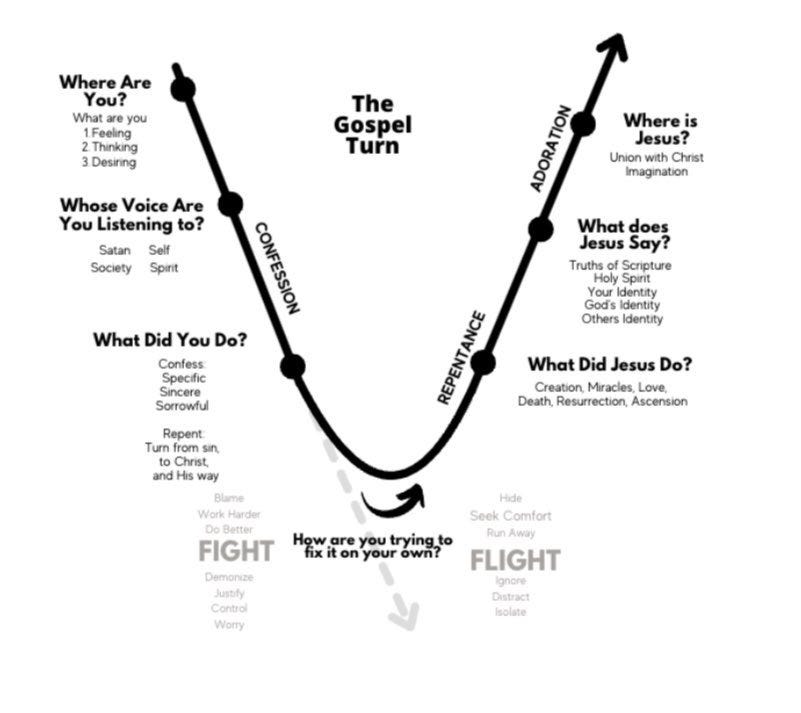Many are undertaking new Bible reading plans with the beginning of a new year (I join you in these new endeavors!). Maybe yours like mine starts with the beginning, Genesis, the Bible's first book.
As I was reading through Genesis 3 it struck me that the Good News of the Gospel is not something confined to the Gospel writers of the New Testament, or the New Testament epistles, but that this euagelion (New Testament word for Gospel) fills the pages of God’s Word.
We can attribute this wonderful truth to the Bible being a unified story that leads to Jesus, as The Bible Project has so wonderfully captured.
The picture above is from a painting titled “Expulsion from the Garden of Eden” by Thomas Cole. It was an oil painting from 1828 that is now part of the art collection of the Museum of Fine Arts in Boston, Massachusetts.
As you can see Cole focused more on the landscape than the figures themselves. Adam and Eve are portrayed as insignificant compared to the grand landscape surrounding them. Their posture and expressions (covering their faces) hint at their disgrace. However, Cole primarily uses the landscape to express the despair from their sin.
The painting, in some ways, reflects our typical approach to reading Genesis 3. Adam and Eve engage in sin through the serpent's deception, and God is seemingly an absent bystander to the event. Even when he is present, it is to bring judgment. But if you read through the chapter closely, you’ll notice that God is actually quite caring in his interactions with the sinful couple.
In the garden, we see God’s judgment against sin and the curse of the fall, but we also see God's grace and the gospel's promise. I count at least five ways that the Gospel is displayed within just a few short verses of Adam and Eve eating from the forbidden tree.
God is Present (3:8)— “Then the man and his wife heard the sound of the Lord God”
Instead of wiping Adam and Eve out or abandoning them, the story takes a surprising turn. God steps into the scene.
He doesn’t turn away. He draws closer. He walks into their brokenness, seeking them out, refusing to leave them lost and hiding.
God Speaks (3:9)— “The Lord God called to the man, ‘Where are you?’”
Upon entering the scene, God speaks, asking, “Where are you?” Of course, God is fully aware of where they are. God does not need the information from them. This is a caring invitational question, not an angry lashing out.
God is speaking to a couple burdened with sin and shame, and by asking them to reveal their location what he’s actually saying is that he desires their presence.
God Calmly Questions (3:10–13)— “What is this you have done?”
“Where are you?” only begins the questions. God continues: “Who told you that you were naked?” and “Did you eat from that tree?” and “What is this you have done?” Remember, God does not need the information, so the questions are for the sake of Adam and Eve.
God is teaching us something about his nature and how he relates with sinful people. God doesn’t force or shove us into understanding. Instead, He patiently guides us, opening our eyes to the truth of our situation and showing us the incredible things He’s prepared to do on our behalf.
God Promises (3:15)— “He will crush your head”
After Eve acknowledges her sin, God speaks to the serpent and includes a glorious promise: A descendant of Eve will destroy the serpent.
The Gospel promise of Christ has already arrived in the Scriptures as God puts this promise onto our sins.
God Provides (3:21)— “The Lord God made garments of skin for Adam and his wife and clothed them”
In recognizing their nakedness, Adam and Eve used leaves to cover themselves, but God had a more substantial idea: an animal skin covering. An animal had to die to provide Adam and Eve with clothing made from animal skins. God Himself shed its blood to cover them.
This moment marks the first sacrifice—a powerful image of a substitute stepping in for sinners. It foreshadows the ultimate act of grace, when Christ would give His life to cover humanity's sins.
The Gospel Turn
Within the interactions between God and Adam and Eve in Genesis 3 are a Gospel invitation to turn away from sin and back to God. Tim Keller highlights God’s pursuing of us as key to understanding the Gospel, saying:
“Certainly we should be very active in seeking God, and Jesus himself called us to ‘ask, seek, knock’ in order to find him. Yet those who enter a relationship with God inevitably look back and recognize that God’s grace had sought them out, breaking them open to new realities.”
Jason Kovacs created a helpful diagram showing “The Gospel Turn” of Genesis 3. Using the questions Christ asks following the fall in Genesis 3, the model helps you move from a place of confessing sin, to repentance (turning away from sin), and to worship and adoration of all God invites us into by His work.
When you realize that the gospel is presented from the beginning of God’s story, it transforms how you read the Bible, especially the Old Testament (for instance, Jesus as the precious lamb in 1 Peter 1:18-19). With this perspective, you start to see redemption woven into the whole story. You notice the gospel taking root and growing throughout Scripture.
The story of the fall becomes more than just a warning about obeying God; instead, it is transformed into a message of hope for those living in a broken, sinful world, trying to cover our guilt and shame with our efforts.
God’s promise in the garden ultimately points us to the cross, where the promise is fulfilled. There, the seed of the woman—the Son of God in human flesh—has his heel bruised as he delivers the fatal blow to the serpent’s head.






